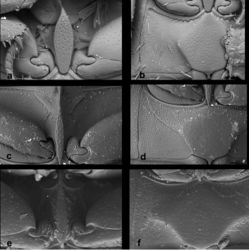Cercyon quisquilius
| Notice: | This page is derived from the original publication listed below, whose author(s) should always be credited. Further contributors may edit and improve the content of this page and, consequently, need to be credited as well (see page history). Any assessment of factual correctness requires a careful review of the original article as well as of subsequent contributions.
If you are uncertain whether your planned contribution is correct or not, we suggest that you use the associated discussion page instead of editing the page directly. This page should be cited as follows (rationale):
Citation formats to copy and paste
BibTeX: @article{Arriaga-Varela2017ZooKeys, RIS/ Endnote: TY - JOUR Wikipedia/ Citizendium: <ref name="Arriaga-Varela2017ZooKeys">{{Citation See also the citation download page at the journal. |
Ordo: Coleoptera
Familia: Hydrophilidae
Genus: Cercyon
Name
Cercyon quisquilius (Linnaeus, 1761) – Wikispecies link – Pensoft Profile
- Scarabaeus quisquilius Linnaeus, 1761: 138.
- Cercyon quisquilium Stephens (1829: 153). For complete synonymy see Smetana (1978)[1] and Hansen (1999)[2].
Figures in Flickr
www.flickr.com/photos/142655814@N07/albums/72157671688128241
Type locality
“Suecia” [= Sweden, without specified locality].
Specimens examined
CUBA: Holguín: Mayarí Municipality, Feltón, Vuelta Larga, permanent lagoon, 23.iii.2013, leg. A. Deler-Hernández (2 spec.: NMPC) [DNA extraction: MF1599].
Published records
JAMAICA: without precise locality (Leng and Mutchler 1917[3]).
Diagnosis
Body size 2.4–3.2 mm; dorsal surface of head completely black; pronotum (Figs 3g, i) black with vaguely defined yellowish to brownish lateral margins, broader in anterolateral corners; scutellar shield black; elytra yellow to brownish-yellow; mesoventral plate (Fig. 13e) narrow, ca. 6.3× as long as wide; metaventrite (Fig. 13f) without femoral lines, with raised pentagonal area very wide, 0.6× as long as wide in widest part; first abdominal ventrite without spiniform process in both sexes; apex of fifth abdominal ventrite without triangularly bulged projection; aedeagus with parameres ca. 0.75× as long as phallobase, narrowing towards slightly lobate apex; median lobe fusiform, without spines.
Cercyon quisquilius was assigned to C. unipunctatus group according to Smetana (1978)[1]. This species can be only confused with C. nigriceps in Greater Antilles. It may be distingushed from it by the coloration of the pronotum (blackish with diffuse yellowish areas on lateral margins in C. quisquilius, almost homogeneously piceous to reddish brown and similar to elytral coloration in C. nigriceps), larger body size (2.4–3.2 mm in C. quisquilius, 1.0–2.1 mm in C. nigriceps), and by metaventrite without femoral lines and with wide raised median part (with femoral lines and narrower median part in C. nigriceps).
Distribution
Cercyon quisquilius is a species native to the Palearctic Region, but currently introduced to the Nearctic, Neotropical and Australian Regions (Smetana 1978[1]; Hansen 1999[2]; Fikáček 2009[4]). We are providing the first precise records of this species from the Caribbean based of specimens from Cuba (Holguín province) (Fig. 15c).
Taxon Treatment
- Arriaga-Varela, E; Seidel, M; Deler-Hernández, A; Viktor Senderov, ; Fikáček, M; 2017: A review of the Cercyon Leach (Coleoptera, Hydrophilidae, Sphaeridiinae) of the Greater Antilles ZooKeys, (681): 39-93. doi
Images
|
Other References
- ↑ 1.0 1.1 1.2 Smetana A (1978) Revision of the subfamily Sphaeridiinae of America north of Mexico (Coleoptera: Hydrophilidae). Memoirs of the Entomological Society of Canada 105: 1–292. https://doi.org/10.4039/entm110105fv
- ↑ 2.0 2.1 Hansen M (1999) World Catalogue of Insects 2: Hydrophiloidea (Coleoptera). Apollo Books, Stenstrup, 416 pp.
- ↑ Leng C, Mutchler A (1917) Supplement to preliminary list of the Coleoptera of the West Indies. Bulletin of the American Museum of Natural History 37: 191–220.
- ↑ Fikáček M (2009) Occurrence of introduced species of the genus Cercyon (Coleoptera: Hydrophilidae) in the Neotropical Region Revista de la Sociedad Entomológica Argentina 68(3-4): 351–357.



